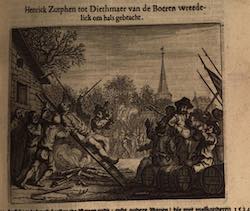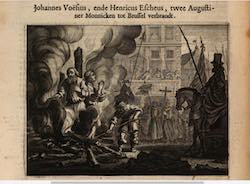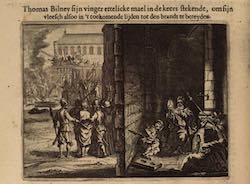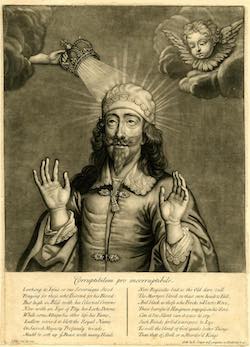Topic: 6. Sacrifices of self: Martyrology after Reformation (16th-18th Century)
During the volatile period between the sixteenth and eighteenth centuries, the concept of martyrdom underwent significant reinterpretations across different Christian denominations. This section explores how Catholics, Protestants, and Anabaptists each uniquely perceived and portrayed martyrdom. Protestants, countering the Catholic notion of sainthood, crafted new martyrologies to establish a lineage of sacrifice rooted in what they deemed as true faith. Similarly, the Anabaptists viewed the state of persecution, as chronicled in their martyrologies, as a testament to being part of the true church. This collection includes a wide array of early modern Catholic, Lutheran, Calvinist, and Anabaptist printed sources and images. It is further enriched by a comprehensive bibliography spanning from the 19th to the 21st Century, offering modern perspectives on these historical interpretations
Mary's Protestant Martyrs and Elizabeth's Catholic Traitors in the Age of Catholic Emancipation
in: Church History, v. 51 (1982), issue 2: pp.172-185.
Martyrs With a Difference: Dutch Anabaptists Victims of Elizabethan Persecution
in: Nederlands archief voor kerkgeschiedenis / Dutch Review of Church History , v. 80 (2000), issue 3: pp.263-281.
The Devil's martyrs: or, plain dealing, in answer to the Jacobite speeches of those two Perjured Rebels William Paul, a Clergyman, and John Hall, a Justice of Peace; fairly proving, no British subject can be a true son of the Church of England that dies asserting that the Pretender has any rights to his Majesty's Crown. To which is added, The high-church martyrology: ... Written by Mr. John Dunton.
London: John Dunton, 1716.
The Suffering Church in Anabaptism
in: Mennonite Quarterly Reviw, v. 59 (1985), issue : pp.5-23.
Samuel Clarke and the ‘Lives’ of Godly Women in Seventeenth-Century England
in: Women in the Church, pp. 365 - 376
Oxford: Oxford University Press, 1990.
Gerard Moyart, ende Pieter de Muelen, tot Pamele levendig verbrandt. (1659)
from: Haemstede, Adriaen Cornelisz van. Historie der martelaren, 1659, fol. 457
Ghent University
Henrick Zurphen tot Diethmaer van de Boeren wreede-lick om hals gebracht. (1659)
from: Haemstede, Adriaen Cornelisz van. Historie der martelaren, 1659, fol. 51
Ghent University
Johannes Frythus ende Andreis Hewet ruggelings aen malkanderen door het vyer gemarteliseert, tot Londen. (1659)
from: Haemstede, Adriaen Cornelisz van. Historie der martelaren, 1659, fol. 79
Ghent University
Johannes Pistorius aen een pael verbrandt, sijn borst openende op dat de Beul het bus-poederdaer op sounde stroyen. (1659)
from: Haemstede, Adriaen Cornelisz van. Historie der martelaren, 1659, fol. 69
Ghent University
Johannes Voësius, ende Henricus Hescheus, twee Augustiner Monnicken tot Brussel verbrandt (1659)
from: Haemstede, Adriaen Cornelisz van. Historie der martelaren, 1659, fol. 50
Ghent University
Thomas Bilney sijn vinger ettelicke maael in de keers stekende, omsijn vleesch alsoo in 't toekomende lijden tot den brandt te beteyden. (1659)
from: Haemstede, Adriaen Cornelisz van. Historie der martelaren, 1659, fol. 77
Ghent University
Les buchers du roi: la culture protestante des martyrs 1523-1572
Seyssel: Champs Vallon, 1997.
The Catholic Martyrs of Wales, 1535-1680
London : Burns and Oats, 1833.
The Rites of Violence: Religious Riot in Sixteenth-Century France. A Comment
in: Past & Present, v. 67 (1975), issue : pp.127-130.
The Rites of Violence: Religious Riot in Sixteenth-Century France. A Comment
in: Past & Present, v. 67 (1975), issue : pp.127-130.
Religion and the Book in Early Modern England: The Making of John Foxe's 'Book of Martyrs'
Cambridge: Cambridge University Press, 2011.







